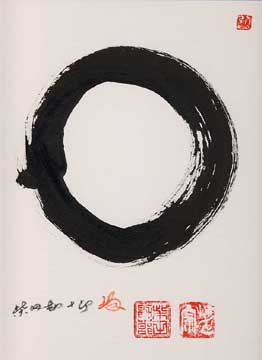
Enso
Encyclopedia

Japanese language
is a language spoken by over 130 million people in Japan and in Japanese emigrant communities. It is a member of the Japonic language family, which has a number of proposed relationships with other languages, none of which has gained wide acceptance among historical linguists .Japanese is an...
meaning "circle
Circle
A circle is a simple shape of Euclidean geometry consisting of those points in a plane that are a given distance from a given point, the centre. The distance between any of the points and the centre is called the radius....
" and a concept strongly associated with Zen
Zen
Zen is a school of Mahāyāna Buddhism founded by the Buddhist monk Bodhidharma. The word Zen is from the Japanese pronunciation of the Chinese word Chán , which in turn is derived from the Sanskrit word dhyāna, which can be approximately translated as "meditation" or "meditative state."Zen...
. Ensō is one of the most common subjects of Japanese calligraphy
Japanese calligraphy
is a form of calligraphy, or artistic writing, of the Japanese language. For a long time, the most esteemed calligrapher in Japan had been Wang Xizhi, a Chinese calligrapher in the 4th century but after the invention of Hiragana and Katakana, the Japanese unique syllabaries, the distinctive...
even though it is a symbol and not a character. It symbolizes the Absolute enlightenment
Enlightenment (spiritual)
Enlightenment in a secular context often means the "full comprehension of a situation", but in spiritual terms the word alludes to a spiritual revelation or deep insight into the meaning and purpose of all things, communication with or understanding of the mind of God, profound spiritual...
, strength, elegance, the Universe, and the void
Mu (negative)
or Wu , is a word which has been translated variously as "not", "nothing", "without", "nothingness", "non existent", "non being", or evocatively simply as "no thing"...
; it can also symbolize the Japanese aesthetic
Japanese aesthetics
The modern study of a Japanese aesthetics in the Western sense only started a little over two hundred years ago. But, by the term Japanese aesthetic, we tend to mean not this modern study, but a set of ancient ideals that include wabi , sabi , and yûgen...
itself. As an "expression of the moment" it is often considered a form of minimalist expressionist art
Minimalism
Minimalism describes movements in various forms of art and design, especially visual art and music, where the work is set out to expose the essence, essentials or identity of a subject through eliminating all non-essential forms, features or concepts...
.
In Zen Buddhist
Zen
Zen is a school of Mahāyāna Buddhism founded by the Buddhist monk Bodhidharma. The word Zen is from the Japanese pronunciation of the Chinese word Chán , which in turn is derived from the Sanskrit word dhyāna, which can be approximately translated as "meditation" or "meditative state."Zen...
painting, ensō symbolizes a moment when the mind is free to simply let the body/spirit create. The brushed ink of the circle is usually done on silk
Silk
Silk is a natural protein fiber, some forms of which can be woven into textiles. The best-known type of silk is obtained from the cocoons of the larvae of the mulberry silkworm Bombyx mori reared in captivity...
or rice paper in one movement (but the great Bankei
Bankei Yotaku
was a well-known Rinzai Zen Buddhist master, and the abbot of the Ryomon-ji and Nyoho-ji. Bankei is best known for his talks on the Unborn as he called it...
used two strokes sometimes) and there is no possibility of modification: it shows the expressive movement of the spirit at that time. Zen Buddhists "believe that the character of the artist is fully exposed in how she or he draws an ensō. Only a person who is mentally and spiritually complete can draw a true ensō. Some artists will practice drawing an ensō daily, as a kind of Spiritual Practice."
Some artists paint ensō with an opening in the circle, while others complete the circle. For the former, the opening may express various ideas, for example that the ensō is not separate, but is part of something greater, or that imperfection is an essential and inherent aspect of existence (see also the idea of broken symmetry). The principle of controlling the balance of composition through asymmetry and irregularity is an important aspect of the Japanese aesthetic: Fukinsei
Japanese aesthetics
The modern study of a Japanese aesthetics in the Western sense only started a little over two hundred years ago. But, by the term Japanese aesthetic, we tend to mean not this modern study, but a set of ancient ideals that include wabi , sabi , and yûgen...
(不均斉), the denial of perfection.
The ensō is also a sacred
Sacred
Holiness, or sanctity, is in general the state of being holy or sacred...
symbol in the Zen school of Buddhism
Buddhism in Japan
The history of Buddhism in Japan can be roughly divided into three periods, namely the Nara period , the Heian period and the post-Heian period . Each period saw the introduction of new doctrines and upheavals in existing schools...
, and is often used by Zen masters as a form of signature in their religious artwork. For more on the philosophy behind this see Hitsuzendo, the Way of the Brush or Zen Calligraphy.

